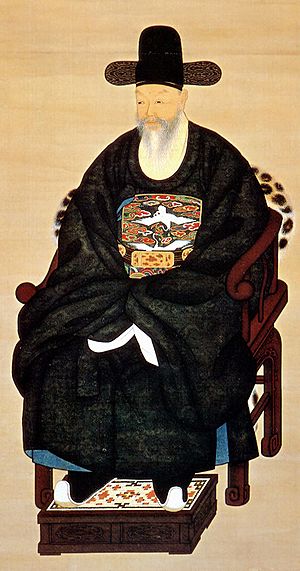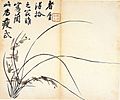Kim Jeong-hui facts for kids
| Kim Jeong-hui | |
 |
|
Quick facts for kids Korean name |
|
|---|---|
| Hangul |
김정희
|
| Hanja |
金正喜
|
| Revised Romanization | Gim Jeonghui |
| McCune–Reischauer | Kim Chǒnghǔi |
Kim Jeong-hui (1786–1856) was a very famous artist and scholar from Korea during the later Joseon period. He was known for his amazing calligraphy (beautiful handwriting) and his deep knowledge of old writings. He also studied ancient inscriptions on stone or metal, which is called epigraphy.
Kim Jeong-hui was part of the Gyeongju Kim family. He used many different pen names, like Wandang, Chusa, and Yedang. He had about 200 pen names in total! He is especially famous for changing how people studied old inscriptions in Korea. He also created his own special writing style called "Chusa-che." This style was inspired by his studies of old Korean and Chinese writings. His ink paintings, especially those of orchids, are also very much admired.
As a scholar, he belonged to the Silhak school, also known as "Northern Learning." This group focused on practical studies rather than just traditional teachings. Kim Jeong-hui was related to important royal figures. He was a cousin to Namyeon-gun Yi Gu, who later became the grandfather of King Gojong. Even Heungseon Daewongun, King Gojong's father and a famous calligrapher himself, was one of Kim Jeong-hui's students for a while.
Contents
Kim Jeong-hui's Life Story
Early Years and Family Background
Kim Jeong-hui was born in 1786 in Yesan, which is now in South Chungcheong Province. He was the oldest son in his family. His family was very important, with many relatives holding high government jobs. Several of them were also known for their beautiful calligraphy. His great-grandfather married a princess, the second daughter of King Yeongjo.
Even as a child, Kim Jeong-hui was said to be a remarkable calligrapher. When he was only 7 years old, a famous scholar named Chae Je-gong was very impressed by a good-luck charm Kim had written. This charm, celebrating the coming of spring, was pasted on the gate of his family home. From the age of 15, he was taught by Pak Je-ga, a well-known scholar from the "Northern Learning" school.
Changes in His Youth
During the 1790s, Kim Jeong-hui's family faced some difficulties. His oldest uncle was sent away from home, and other relatives, including his grandparents, passed away. Because his uncle had no son, it was decided that Kim Jeong-hui would be adopted by him. This meant Kim would become the next head of that part of the family.
In 1800, when he was 15, Kim Jeong-hui got married. That same year, King Jeongjo died. The new king was very young, so Queen Jeongsun, the previous king's wife, became the regent. This meant she ruled the country until the new king was old enough. Kim Jeong-hui's birth father gained a higher position in the government because of his family's connection to the regent.
Later Youth and Important Events
Kim Jeong-hui faced more sadness in his early twenties. His birth mother died in 1801. Queen Jeongsun died in 1805, and his young wife passed away just a few weeks later. His teacher, Pak Je-ga, also died that year. These many losses made him even more interested in Buddhism, which offered him comfort and meaning.
His adoptive mother also died around this time. After a period of mourning, he married his second wife in 1808. In 1809, he did very well in the lower Gwageo civil examination, which was a test to become a government official.
Journey to China
In 1810, Kim Jeong-hui traveled to Qing China with his birth father, who was a vice-envoy. They stayed in China for about six months. There, he met famous scholars like Weng Fanggang and Ruan Yuan, who recognized his talent. He studied historical documents there, especially. Ruan Yuan gave him a book about calligraphy. Kim continued to write to these scholars even after he returned to Korea.
After coming home, he didn't immediately take an official job. Instead, he kept studying "Northern Learning" and wrote essays that criticized the strict traditional teachings of Neo-Confucianism. He also visited old stone monuments to study their inscriptions. In 1815, a Buddhist monk named Cho-ui visited Seoul and met Kim Jeong-hui. This meeting started a very close and lasting friendship between them.
Success and Challenges
In 1819, Kim Jeong-hui passed the national Gwageo exam. He then held important positions, like a secret inspector and a tutor to the Crown Prince. However, after the prince died, a powerful family called the Andong Kim clan gained control. Kim Jeong-hui's rank was lowered, and his adoptive father was sent away from home for several years.
Things changed for Kim Jeong-hui's family in 1835, when King Heonjong became king. Kim Jeong-hui rose to a high government position. In the same year, he visited his friend, the monk Cho-ui, at Daeheung-sa temple.
Time in Exile
After King Sunjo of Joseon died in 1834, Queen Sunwon, who was from the powerful Andong Kim clan, became very influential. Her grandson, Heonjong, was still a child, so she acted as regent. During this time, political disagreements grew, and in 1840, Kim Jeong-hui was sent away to Jeju Island as a punishment. This was called exile.
While in exile, his wife died in 1842. He was finally allowed to return home in 1849. It was during these years in Jeju that he developed his famous "Chusa style" of calligraphy. This style was based on his deep study of old Korean and Chinese writings. On his way to and from exile, he visited his friend, the monk Cho-ui, at Daeheung-sa temple. Cho-ui helped Kim during his exile, even visiting him on Jeju Island several times and bringing him gifts of tea.
In 1844, while still in Jeju, Kim Jeong-hui created his most famous ink painting, called "Sehando" or "Wandang Sehando." This painting shows a simple house and two old pine trees. He gave it to his student Yi Sang-jeok to thank him for his friendship, especially for bringing him valuable books from China. Yi Sang-jeok was a talented poet and calligrapher who traveled to China many times. In 1845, Yi took the painting to China and showed it to scholars there. Sixteen of them wrote appreciative comments, which were added to the painting, making it a long scroll. Later, Korean scholars also added their tributes, creating a unique work of art that combined painting, poetry, and calligraphy.
Soon after King Heonjong died in 1849, there were disagreements about moving his tomb. Kim Jeong-hui's friend was involved in this, and as a result, both were sent into exile again. Kim spent the years 1850–1852 in Bukcheong, a far northern province.
Final Years and Legacy
After his second exile, Kim Jeong-hui settled in Gwacheon, south of Seoul, where his birth father was buried. He called his house Gwaji Chodang. In 1856, he stayed for a while at Bongeun-sa temple in what is now Seoul's Gangnam area. It is said he became a monk there. Later that year, he returned home to Gwacheon and continued to write until the day before he died.
After his death, his students collected and published his letters and poems. A complete collection of his works was published in 1934 by his great-great-grandson.
Kim Jeong-hui's Achievements
Kim Jeong-hui had a huge influence on Korean scholars in the late 1800s. It is said he taught 3,000 students. He was seen as a leader of a movement that aimed to modernize Korea. Many important figures of that time were associated with him.
His main scholarly interest was in studying historical documents and inscriptions on monuments. He wrote to major scholars in China about these topics. He was especially famous for figuring out and identifying a stone monument on Mount Bukhan. This monument celebrated a visit by King Jinheung of Silla (540–576).
Kim Jeong-hui is remembered for his amazing work in calligraphy, ink painting, and his writings. He often created a special pen name for himself whenever he painted orchids for a friend. Because of this, he had more pen names than anyone else of his time.
His Connection to Buddhism
It seems Kim Jeong-hui visited Buddhist temples from a young age. When several close people died around 1805, he became even more interested in Buddhist practices. Many of his calligraphic works are copies of Buddhist texts. He also wrote name boards for halls in Daeheung-sa, Bongeun-sa, and other temples. Scholars who followed the "Practical Learning" tradition often showed interest in either Catholicism or Buddhism. This was part of their way of reacting against the very strict traditional Neo-Confucianist philosophy.
He was especially close to the Buddhist monks Cho-ui Seonsa and Baekpa Daesa. In 1815, Cho-ui visited Seoul and became good friends with many highly educated scholars and officials, including Kim Jeong-hui. It was unusual for a Buddhist monk, who had a low social rank, to be recognized as a poet and thinker by Confucian scholars. Because monks were not allowed inside the city walls of Seoul, Cho-ui had to meet these scholars outside the capital.
Kim Jeong-hui had a friendly debate with another famous monk, Baekpa Geungseon, about Buddhist teachings. Kim believed that the true nature of Seon (a type of Buddhism) was simple and pure, and that arguing about which traditions were better was a waste of time. Even so, when Baekpa died in 1852, Kim wrote a special inscription for his tomb.
Family
Parents
- Biological father: Kim No-kyung (김노경)
- Biological mother: Daughter of Yoo Junju (유준ju)
- Brother: Kim Myeong-hui (김명희)
- Brother: Kim Sang-hui (김상희)
- Adoptive father: Kim No-yeong (김노영)
- Adoptive mother: Daughter of Hong Dae-hyeon (홍대현)
Wives and issues:
- Lady Yi, of the Hansan Yi clan (한산이씨)
- Kim Sang-mu (김상무), adopted son
- Lady Yi, the Yean Yi clan (예안 이씨)
- Lady Han, of the Han clan (한씨)
- Kim Sang-U (김상우), first son
Images for kids
See also
 In Spanish: Kim Jeong-hui para niños
In Spanish: Kim Jeong-hui para niños







